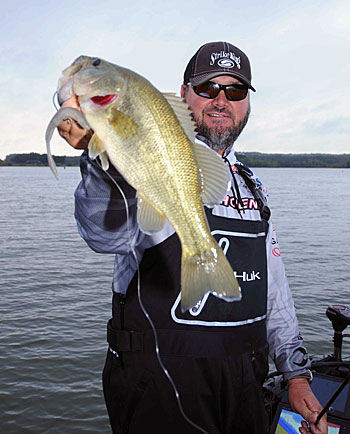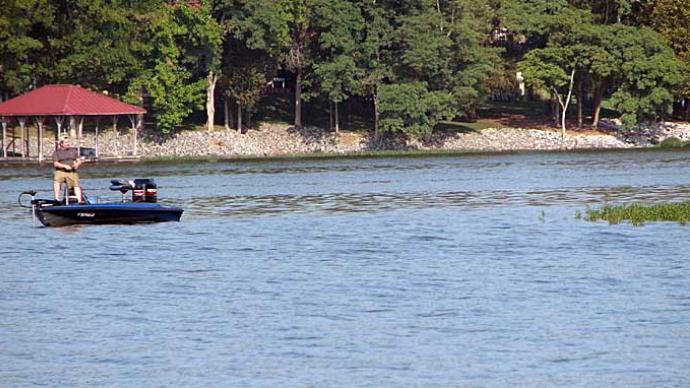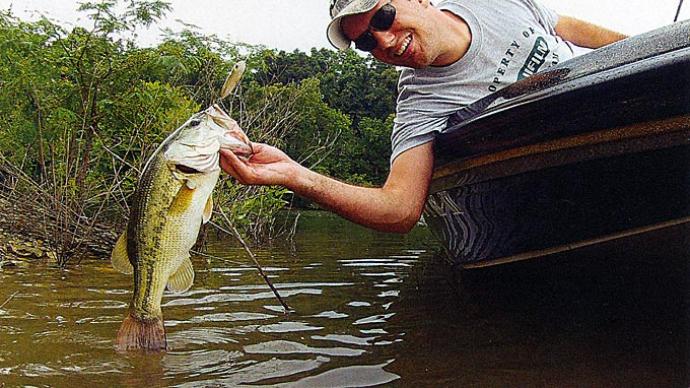
Most bass anglers dread cold fronts, but Greg Hackney has a different view of this weather phenomenon in the fall.
The Louisiana pro notices cold fronts in the spring have a negative effect on bass because the fish are coming out of winter and cold water. “A fall cold front, on the other hand, seems to stimulate the bite,” Hackney says.
The length of daylight in the fall shortens, and bass move to the shallows to feed up for winter. “It seems like when we get a cold front in the fall, it just seems to fire up the bass,” Hackney says. “They know it is time to put on a feed bag and eat.”
The passage of a cold front during fall will still slow down the bite but with less severity than a spring cold front. Hackney notices he can still catch bass the first day after the front passes, but the bite slows down the second day. “Two days after the actual front passes are always the toughest conditions because you have those cobalt blue skies and no wind,” he says. “By Day 3, it seems like conditions start to get back to normal again, and fish start to bite again.”
Targeting areas where bass were feeding on shad before the front is a key to catching bass after a cold front. “The fish don’t move much,” Hackney says. “Wherever they were before the front, they will typically stay in that area but will be a little more cover oriented. Typically the ones that are close to cover are easier to catch.”
Hackney keys on cover such as rocks or logs during those slick, sunny post-frontal conditions. “I will throw at a log 20 or 30 times, and then I will come back and do it again if I know there is a fish around it or it is a place where multiple fish are going,” he says. “I will just keep hitting it.”
The calm weather and blue skies cause Hackney to abandon fast-moving lures such as buzzbaits, spinnerbaits, or topwaters that worked before the front and switch to a Strike King Caffeine Shad. He favors this soft plastic jerkbait because it imitates a shad, and he can work it fast or slow. The tournament veteran can fish the lure weightless and let it sink to the bottom in open water, or he can skip it under boat docks to bass hiding in the shade.
The six-time B.A.S.S. winner tries to match the baitfish size throughout autumn. He notices the shad are little in early fall, so he uses a 4-inch Caffeine Shad after cold fronts. “Once we have had a couple of cold fronts, then I will increase my lure size,” he says. By late fall, large shad from the main channel become a favorite forage of bass, so Hackney switches to the 5-inch Caffeine Shad.
When fishing a lake featuring clear and dirty water, Hackney prefers running to the off-color water after a cold front hits the area. He believes the dirty water gives him a better chance to get bites, especially on the second day of a front when bass seek cover and are easier to pinpoint. “I can be more aggressive and crank any wood with a (Strike King KVD) 1.5 or 2.5 squarebill or maybe keep a spinnerbait in my hand,” he says. “The only difference is before the front, all I had to do was get the bait around the fish, and it would bite, and after the front, I will use the same bait to be repetitive with.”

“If there is a log on a flat and there is shad on that flat and those bass were there before, I know that log has a bass on it,” Hackney says. “If the water is dirty, I can keep putting that lure in there to make that fish bite.” So Hackney will make repeated presentations to the cover and try different angles to tempt the fish holding tight to the cover.
Lakes are usually low in the fall, making cover sparse, but if Hackney finds any thick cover still in the water, he will pitch or flip a tube bait or jig after a cold front. Hackney pitches a 1/2-ounce jig throughout the summer, but he scales down to a 3/8-ounce version in the fall. The lighter jig presents a slower fall to cold front bass holding tight to shallow cover.
As fall progresses and cold fronts continue to cool down the water, bass remain in the shallows as long as the baitfish remain there. “What I find about fall is bass stay shallow for a long time,” Hackney says. “It typically takes the water temperature below 50 for the fish to leave.”
Until then, Hackney still has a favorable view of cold fronts because he knows he can still catch bass in the shallows.




